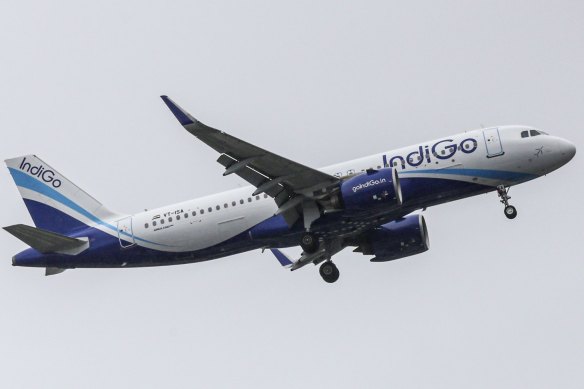Opinion
Giant airports, more routes: The new powerhouse in air travel
Michael Gebicki
The TripologistIndia’s aviation sector is on a roll. In the period January-November 2023, the country’s airlines carried 25 per cent more domestic passengers than in the corresponding period in 2022. In mid-2023, national airline Air India ordered 250 aircraft from Airbus and another 220 from Boeing, worth a total of $US70 billion ($107 billion) at list prices.

Campbell Wilson, chief executive officer of Air India, speaks during an unveiling event for the carrier’s rebranded look in New Delhi last year.Credit: Bloomberg
That order came hot on the heels of an order from India’s leading low-cost IndiGo airline for 500 new Airbus aircraft. In January 2024, Akasa Air, India’s newest airline, announced an order for 150 Boeing 737s. Alongside its commercial airlines, government and private industry are spending big on aviation infrastructure and now there is barely a corner of the country beyond the reach of air travel. If you want, you can take a one-hour flight from Delhi over the Himalayas and land at Leh, capital of Buddhist-infused Ladakh, and stagger off the plane into rarefied air at an altitude of 3256 metres.
The Australia connection
Two-way air traffic between Australia and India is also booming. In the 12 months to November 2023, 387,000 Indian residents visited Australia, a rise of 40 per cent over the previous 12 months. In the 2022-23 financial year, 435,000 Australian residents visited India. In the previous financial year the figure was 61,000.
Qantas halted its non-stop services between Australia and India in 2012 while Air India maintained the Australia-India connection, only pausing during the pandemic. On November 15, 2021 Air India resumed its thrice-weekly Sydney-New Delhi service. Three weeks later, Qantas began operating a non-stop flight between Delhi and Sydney. In the week beginning December 15, 2023, Air India began a thrice-weekly service between Melbourne and Mumbai. This is the first non-stop flight between any Australian city and India’s financial powerhouse since Qantas stopped its Mumbai flights more than a decade ago.
Air India operates a non-stop service between Sydney and Delhi but Qantas no longer does. Qantas flight 67 from Sydney makes a stop in Bengaluru, India’s IT capital. Passengers continuing to Delhi are carried aboard an IndiGo flight.
India’s largest budget airline, IndiGo takes a pared-back approach to customer service. Seats aboard the airline’s Airbus A321 all-economy flights have a pitch of 74 centimetres, five centimetres less than an economy-class seat aboard the Qantas Airbus A330-200 connecting flight. There are no inflight entertainment screens or power outlets. Anyone travelling from Sydney to the Indian capital with Qantas will have a better flying experience if they take the Qantas flight to Melbourne and connect with the non-stop flight from there to New Delhi.
Air terminals ramp up to meet demand
To cope with India’s appetite for air travel, new air terminals are being built at a rapid rate. Over the past decade, the number of commercial airports has doubled, from 74 to more than 140. Before the end of the decade the Indian Government wants to increase that number to 220. The country is currently in the middle of a two-year, $US12 billion ($18.5 billion) spend on new airports.
Among the major airports scheduled to begin operations soon, New Delhi’s Noida International Airport will relieve congestion at New Delhi’s Indira Gandhi International Airport. Expected to welcome its first commercial flights late in 2024, Noida International’s management has recently upgraded expected initial passenger numbers from 4.1 million to 6.5 million due to the rapid expansion of India’s air travel sector and the enormous new aircraft orders from Air India and budget operator Indigo. A rapid, elevated rail link is planned to slash travel time between city centre and airport to 60 minutes.

Mumbai’s Navi Airport will open next year.
With an anticipated opening date of early 2025, Navi Mumbai International Airport will take some of the pressure off the city’s Chhatrapati Shivaji Maharaj International Airport. Located in a planned city on the eastern side of the harbour from Mumbai, Navi Mumbai expects to commence operations with two phases of the four-stage project complete, allowing it to handle 25 million passengers annually. Upon completion the airport will have an annual capacity of 90 million passengers, making it one of the world’s busiest airports.
India’s airlines expand
Budget carrier IndiGo has a fleet of 319 aircraft, all narrow-body Airbus apart from a handful of ATR72s and three Boeing 777-300ERs, however the first deliveries of the 500 new aircraft ordered from Airbus will not happen until the end of the decade.

IndiGo is growing rapidly.Credit: Bloomberg
From its New Delhi hub the airline operates an extensive domestic network and international flights to Bangkok, the Gulf States and Saudi Arabia. Its domination is set to be challenged by Air India Express, the low-cost offspring of Air India, currently with a fleet of just 26 aircraft but set for massive growth when it takes delivery of the 190 Boeing 737 MAX 8 aircraft which Air India ordered during the 2023 Paris Air Show.
Vistara is a joint venture between Tata Sons Private Limited and Singapore Airlines. It’s the pick of India’s carriers, with a far-reaching domestic network and international services to Europe, the Middle East and East Asia. A merger with Air India is projected, at which time Singapore Airlines will have a 25 per cent stake in Air India.
In January 2022 the Indian Government sold Air India to the Tata group, a vast conglomerate which makes everything from tea to steel, cars, most of the trucks and buses on India’s roads, operates power stations, builds houses and telecommunications systems and employs a workforce of more than a million.
Under Tata ownership Air India has spent billions of dollars to upgrade its fleet, revitalise customer services and expand its domestic and international networks, but turning around a lacklustre, dysfunctional airline has been challenging. Just one example, in the 18 months following the Tata takeover, 40 per cent of the seats on its aircraft, 99 per cent of in-flight entertainment screens in business class and first class and 90 per cent in economy seats have been repaired or replaced. Air India has committed over $US400 million for new interiors for its entire legacy widebody fleet of Boeing 787-8s and Boeing 777 aircraft.
What’s in it for Australian travellers?
According to the latest census results, almost 700,000 people living in Australia in 2021 were born in India. Add to that the number of children living in Australia who have one or more parents born in India and the total is well over a million Australian residents. For that population the ties to India are strong and visits to their ancestral homeland are a high priority, ensuring strong demand for air travel between our countries.
For Australians without such ties, the increasing availability of non-stop flights adds the airline hub cities of Delhi, Mumbai and Bengaluru to the list of potential destinations, as well as the possibility of using India as a convenient stopover on flights between Australia and Europe. Finally, more competition helps lower air travel prices, and that’s what’s needed right now.
Sign up for the Traveller newsletter
The latest travel news, tips and inspiration delivered to your inbox. Sign up now.